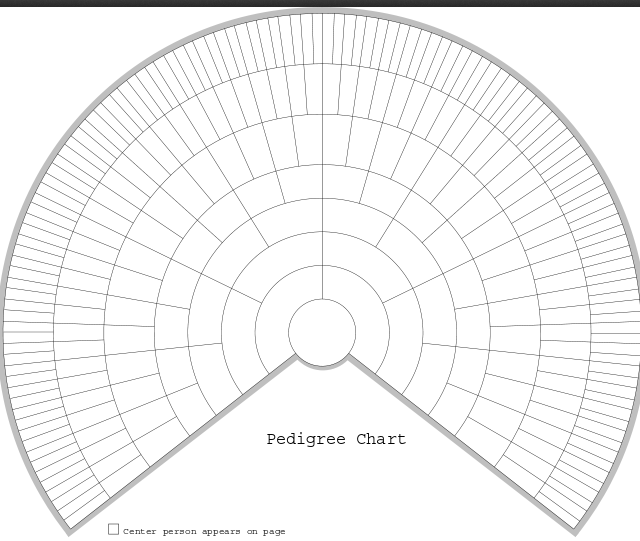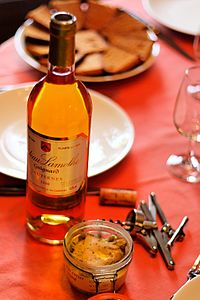|
Temper of the times
in which we look for the positive first 10

Replica of a microscope by Antonie van Leeuwenhoek. ( Credit.) 10A
1675: The year Jakob Lukas van IJken, was born, is also the year in which science advanced significantly. Antonie van Leeuwenhoek, a Dutch amateur scientist, begins using self-made microscopes for observing human tissue sand liquids. He is rightly named the father of microbiology. 10A1
Also that year, Gottfried Wilhelm Leibniz, who invented calculus about the same time Isaac Newton did, was first to use it to calculate the area under the graph of a curve. Calculus is the mainstay of modern physics. 10A2
And in London, construction began of the Royal Greenwich Observatory which since gained considerable reknown by its choice, in 1884, for marking the zeroth meridian on our geographic grid. 10A3
And in India, on November 11, Sikh Guru Teg Bahadur is executed by Mughal rulers because he defended the right of Hindus to practice their own religion. 10A4
The Dutch painter Johannes Vermeer died that year. Vermeer invented and applied in his photorealistic craft an optical technique secret to the world of art and only recently reconstructed.* (It may be noted that Van Leeuwenhoek and Vermeer were contemporaries, both living in Delft.) 10A5
1975 saw plenty of militairy strife (what else is new?), notably between American colonists and native tribes. 10A6
1697: Lukas Jacobsz van IJken was born that year, but my curiosity was aroused more by the comment that in that same year the Royal African Company lost its monopoly on the slave trade. There is a bit more to the company than just that! Let's see ... 10B
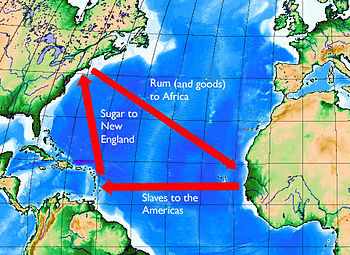
Depiction of the Triangular Trade of slaves, sugar, and rum with New England instead of Europe as the third corner. ( Credit.) 10B1
Briefly, by charter of the King of England, the company was given the right to set up forts and factories, maintain troops, and exercise martial law in West Africa, in pursuit of trade in gold, silver, and slaves. Slavery had always been part of everyday life but the scale increased as slaves were exported to work elsewhere in the triangular trade. In the 1680's, the company was transporting about 5,000 slaves a year across the Atlantic. Many were branded with the letters 'DY', for its Governor, the Duke of York, others with the company's initials, RAC, on their chests. the company's profits made a major contribution to the increase in the financial power of those who controlled the City of London. In 1698, a change was enacted into law by openingan up the African trade to all English merchants, provided that they paid a ten percent levy to the company on all goods exported from Africa. The number of slaves transported on English ships subsequently increased dramatically. Finally, on a different note, the Royal African Company provided gold to the English Mint from 1668 to 1722. Hence, the coinage's name, the guinea. 10B2
Another happening in 1697, the use of palanquins increases in Europe. What are palanquins? Being also known as sedan chairs, the illustration below answers the question. 10B3
 A Rococo sedan chair arrives at a garden party, depicted in a 19th-century oil painting by G. Borgelli. They fell in disuse, probably because of better road paving and the advent of comfortable, horse-drawn carriages. ( Credit.) 10B4
French writer Charles Perrault published "Histoires ou contes du temps passé" ("Mother Goose tales"), a collection of popular fairy tales, including Cinderella, Puss 'n Boots, Red Riding Hood, The Sleeping Beauty, and Bluebeard. 10B5
Hanged on January 10, Scottish student Thomas Aikenhead. He was the last person in Great Britain to be executed for blasphemy. 10B6
Also in 1697, Russian Czar Peter the Great went with a staff of top diplomats on a diplomatic mission through Europe. He did so incognito under the name "artilleryman Pyotr Mikhailov" and used the opportunity to visit a number of shipyards. In August, he went to the Dutch town Alkmaar to work a shipbuilder. He subsequently modernized the Russian navy with the knowledge thus acquired. 10B7
As for wars, Prince Eugene of Savoy crushes the Ottoman army of Mustafa. 10B8
The Treaty of Ryswick signed by France and the Grand Alliance to end both the Nine Years' War and King William's War. The Nine Years' War (1689–97), also called the War of the Grand Alliance or the War of the League of Augsburg, was the third major war of Louis XIV of France, in which his expansionist plans were blocked by an alliance led by England, the United Provinces of the Netherlands, and the Austrian Habsburgs. The deeper issue underlying the war was a balance of power between the rival Bourbon and Habsburg dynasties. The conflict having been inconclusive, had exhausted the combattants' national treasuries. However, the treaty did not resolve any burning issue and the peace lasts only five years. 10B9
1732: In August of the year Hendrik Lucas van IJken was born, Mikhail Gvozdev made the first known crossing of the Bering Strait—from Cape Dezhnev in Siberia to Cape Prince of Wales in Alaska. Gvozdev was a Russian military geodesist and commander of an expedition to Alaska in 1732, when Alaskan shore was for the first time sighted by Russians. (Thirty-five years later, the Russians sold Alaska to the U.S.) 10C
That year also, a magnitude 5.8 earthquake shook Montreal. The event was one of the major earthquakes that occurred in the Western Quebec Seismic Zone. The zone averages about one seismic event every five days, mostly under 4.0 on the Richter scale. 10C1
1775: Lucas van IJken born and the American Revolution begins. The Dutch Republic sympathizes with the American patriots and sells them weapons. 10D
Human knowledge and mastery over nature advances when James Watt builds a successful prototype of a steam engine, and a scientific expedition continues as Captain James Cook claims the South Georgia and South Sandwich Islands in the south Atlantic Ocean for Britain. Cook's contributions to knowledge were internationally recognised during his lifetime. In 1779, while the American colonies were fighting Britain for their independence, Benjamin Franklin wrote to captains of colonial warships at sea, recommending that if they came into contact with Cook's vessel, they were to "not consider her an enemy, nor suffer any plunder to be made of the effects contained in her, nor obstruct her immediate return to England by detaining her or sending her into any other part of Europe or to America; but that you treat the said Captain Cook and his people with all civility and kindness,... as common friends to mankind." 10D1
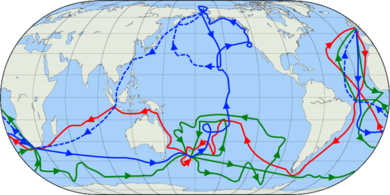 The routes of Captain James Cook's voyages. The first voyage is shown in red, second voyage in green, and third voyage in blue. The route of Cook's crew following his death in Hawaii is shown as a dashed blue line. ( Credit.) 10D3
While human knowledge and mastery over nature advance, nature does occasionally bite back. On September 13, 1975, the "Independence Hurricane" utterly devastated the east coast of North America with 4,173 dead; and also that year the Tseax Cone, in the future British Columbia, erupts. 10D4
Moreover, that year, a smallpox epidemic broke out in New England. Smallpox was then cured by Edward Jenner, who pioneered vaccination whence it is said that he saved more lives than any other human. 10D5
Also on a happy note: Wolfgang Amadeus Mozart wrote his five violin concertos in Salzburg. 10D6
1803: The year Hendrik Lucas van IJken was born also saw the publication of the first guide to restaurant cooking, in Paris. Gourmet is a cultural ideal associated with the culinary arts of fine food and drink, or haute cuisine, which is characterised by refined, even elaborate preparations and presentations of aesthetically balanced meals; calories be damned. 10E1
Opened in England: the first public railway. 10E2
Further that year, Jacques-Donatien Le Ray de Chaumont the "father of the Amrican Revolution." died. A Frenchman the father of the American Revolution—how is that?
On July 4, 1776, the American colonies declared their independence from Great Britain, Following that, the new United States revolutionary government dispatched emissaries, headed by Benjamin Franklin, to France to seek assistance from the French king. But for political reasons, Louis IV could not recognize the former colonies officially. However, the wealthy aristocrat Le Ray de Chaumont used his influence to gain substantal help in the form of money and French armed forces. For an aristocrat in that day and age, what Le Ray did for ordinary Americans was astonishing. At heart, he believed in the equality of all men and backed up his beliefs by providing massive amounts of his own money to purchase weapons, supplies and clothing for the fledgling American armed forces. Le Ray was asked by the American government to take charge of the equipment and management of the combined French and American naval fleet. Working closely with Admiral Charles-Hector Estaing, Commander of the French Fleet, Le Ray's had his shipyards refit a merchant vessel into a warship that he then gifted to America under the name "USS Bonhomme Richard" for use by Captain John Paul Jones. And thus it was that a French nobleman became father of the American revolution. But later, when the French revolution broke out, well, he was against it. 10E3
In Marbury vs. Madison, the United States' Supreme Court establishes the principle of judicial review. 10E4
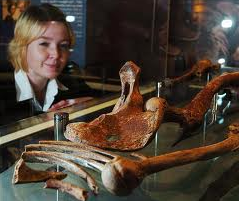
Here's looking at you, kid! The Red Lady of Paviland under the flesh. ( Credit.) 10F
1823: Lucas van Eijken was born. In January, William Buckland discovers the "Red Lady of Paviland", the first identification of a prehistoric human burial, in Paviland Cave on the Gower Peninsula of Wales. The bones, colored with ocre, were found to be about 33, 000 years old, which takes us back to the Upper Paleolithic. Oh, before I forget, the lady turned out to be a male. 10F1
February 20—Explorer James Weddell's expedition to Antarctica reaches latitude 74°15'S" and longitude 34°16'45" W: the southernmost position any ship had reached before, a record that will ve held for more than 80 years. 10F2
April 13—Eleven-year-old Franz Liszt gives a concert after which he is personally congratulated by Ludwig van Beethoven. 10F3
July 1—The congress of Central America declares absolute independence from Spain, Mexico, and any other foreign nation, including North America. The Congress was a republic that consisted of the present-day states of Guatemala, El Salvador, Honduras, Nicaragua, and Costa Rica. 10F4
July—In the U.K., Robert Peel ensures the passage of five Acts of Parliament thereby effectively abolishing the death penalty for more than a hundred offences. In particular. Among them, the Judgement of Death Act which gave judges the discretion to commute sentences for capital offences, other than murder or treason, to imprisonment or exile. British loss was Australia's gain. Actually, the Act required judges to enter a sentence of death on the court record, but then allowed them to commute the sentence. 10F5
When a system is taken through different thermodynamic states and returned whence it began, it is said to have gone through a Carnot cycle. It is a theoretical limit of just how efficient an engine might be, a limit that can't be reached. So stop dreaming of building a perpetuum mobile!
August 22—Died: Lazare Carnot, French general, politician, and mathematician (born in 1753). His name is enshrined in the Carnot cycle beloved by engineers and thermodynamicists. When a system is taken through different thermodynamic states and returned whence it began, it is said to have gone through a Carnot cycle. It is a theoretical limit of just how efficient an engine might be, a limit that can't be reached. Carnot's theorem is a formal statement of this fact: No engine operating between two heat reservoirs can be more efficient than a Carnot engine operating between those same reservoirs. So stop dreaming of building a perpetuum mobile. 10F6
September 11—Also died: David Ricardo, English economist (born in 1772). Perhaps his most important legacy is his theory of comparative advantage, which suggests that a nation should concentrate its resources solely in industries where it is most competitive on the international market place. For Ricardo some form of Central Economic Planning was a given. Ricardo's theory of comparative advantage has been challenged by, among others, but remains the cornerstone of the argument in favour of international free trade as a means of increasing economic prosperity. The theory of comparative advantage is the guiding theme for the economic policy currently promoted by the OECD and the World Trade Organization. 10F7
September 22—Joseph Smith, Jr. claimed in 1838 that on this day an angel directed him to the place where the golden plates, inscribed with Judeo-Christian history of an ancient American civilization were buried. In 1830, he published an English translation now known as the Book of Mormons and organized the Church of Christ. Its members are known as Latter-Day Saints or Mormons. 10F8
October 5—The medical journal "The Lancet" founded in London by Thomas Wakley. 10F9

Olber's Paradox: Why is the night dark? ( Credit.) 10F10
November—According to tradition, William Webb Ellis invented rugby football at Rugby School in England.
Further that month, German astronomer Heinrich Wilhelm Olbers described the paradox named after him in which he wonders why the night sky is dark if there are infinitely many stars. (If your curiosity gets the better of you, look here.)
Work began on the British Museum in London, designed by Robert Smirke, and the Altes Museum in Berlin, designed by Karl Friedrich Schinkel. 10F11
1865: Hendrik van Eijken born.—On January 31—The Thirteenth Amendment to the United States Constitution (conditional prohibition of slavery and involuntary servitude) passes narrowly in the House of Representatives. 10G
February 21—John Deere received a patent for ploughs and the first train robbery in the United States took place (In North Bend, Ohio (a suburb of Cincinnati.) 10G1
May 17—International Telegraph Union founded. 10G2
July—The Christian Mission, later renamed the Salvation Army, is founded in Whitechapel, London, by William and Catherine Booth. 10G3
July 4—Lewis Carroll publishes his children's novel Alice's Adventures in Wonderland in England. 10G4
July 5—The U.S. Secret Service is founded and in Britain the first speed limits are set at 2 mph (3.2 km/h) in town and 4 mph (6.4 km/h) in the country. 10G5
July 14—The summit of the Matterhorn in the Alps is reached for the first time, by a party of seven led by the Englishman Edward Whymper. Four die in a fall during the descent. 10G6
July 21—Wild Bill Hickok shoots Dave Tutt dead in what is regarded as the first true western showdown. (In the market square of Springfield, Missouri.) 10G7
August 12—Died: William Jackson Hooker, English botanist (born in 1785). Hooker succeeded in convincing the British government that botanists should be appointed to their expeditions. While many of his important contributions to botany were in progress, his world-famous herbarium received large and valuable additions from all parts of the globe. He is famous for recommending which foreign species should be cultivated for their usefulness. 10G8
September 2—Died: William Rowan Hamilton, Irish mathematician (born in 1805). The Hamilton Equations, originally concerned with the global movement of the oceans' tides, are the mathematical foundation for quantum theory. 10G9
December 6—Slavery is legally outlawed in the last two slave states, Kentucky and Delaware, and the remaining 45,000 slaves are freed. 10G10
December 24—Jonathan Shank and Barry Ownby form the infamous Ku Klux Klan in the American South. 10G11
1902: Christiaan Theodorus Eduard van Eijken born.—The writings of the priest Alfred Loisy spark among Roman Catholics "the Modernist Crisis." Modernism is a break with the past that embraces theological opinions expressed during the late 19th and early 20th centuries, but with influence reaching into the 21st century. Modernism involves among other notions:
a. A rationalistic approach to the Bible. The rationalism that was characteristic of the Enlightenment took a dim view of miracles and of the historicity of biblical narratives.
b. A distinction between political and religious ideas and structures. Such a distinction was opposed by mainstream Catholic theologians who, following St. Thomas Aquinas, argued that this was not possible, that all aspects of society were to be organized with the final goal of Heaven in mind.
For his views and writings, Loisy was excommunicated vitandus (i.e. to be shunned for life) in 1908. 10H11
January 1—Nurses Registration Act 1901 comes into effect in New Zealand, making it the first country in the world to require state registration of nurses. On January 10, Ellen Dougherty became the world's first registered nurse. 10H2
February 15—The Berlin U-Bahn underground is opened. 10H3
March 10—A Circuit Court prevents Thomas Edison from having a monopoly on motion picture technology. 10H4
April 2—Electric Theatre, the first movie theater in the United States, opens in Los Angeles. 10H5
May 29—Lord Rosebery opens London School of Economics. 10H6
September 19—Shiloh Baptist Church disaster, a stampede at the Shiloh Baptist Church in Birmingham, Alabama, after a talk by Booker T. Washington, kills 115. According to contemporary accounts published in "The New York Times," the disaster occurred after Washington concluded his remarks. A convention delegate from Baltimore engaged in a dispute with the choir leader concerning an unoccupied seat. Someone in the choir yelled, "A fight!" Mistaking the word "fight" for "fire," the congregation rose en masse and started for the door. Human stampedes are not exactly uncommon as this footnote shows. 10H7

A German teddy bear from around 1954. ( Credit.) 10H8
Around November—The first teddy bear is produced by Morris Michtom in the United States. The toy was independently developed by Michtom and Richard Steiff in Germany. Given permission to do so, Michton named the bear after then U.S. President, Theodore ("Teddy") Roosevelt. The April 1972 issue of "The Veterinary Record" included a paper on the diseases of Brunus edwardii: a description of lost limbs and thinning hair, accompanied by sketches of a teddy bear resembling Winnie the Pooh. 10H9
December 10—The first Aswan Dam on the Nile is completed and Nathan Stubblefield demonstrates his mobile phone device in Kentucky. 10H10
September 26—Died: Levi Strauss, inventor of Jeans (born in 1829). 10H11
September 29—Died: Émile Zola, French author (born in 1840). 10H121
November 22—Died: Friedrich Alfred Krupp, German industrialist (born in 1854). 10H13
December 4—Died: Charles Dow, American journalist, co-founder of Dow Jones & Company (born in 1851) 10H14
Nobel Prizes in 1902:
Physics: Hendrik Antoon Lorentz and Pieter Zeeman "For their researches into the influence of magnetism upon radiation phenomena."
Chemistry: Hermann Emil Fischer: for his work on sugar and purine syntheses.
Physiology or Medicine: Ronald Ross "For his work on malaria, by which he has shown how it enters the organism and thereby has laid the foundation for successful research on this disease and methods of combating it."
Literature: Christian Matthias Theodor Mommsen, "The greatest living master of the art of historical writing, with special reference to his monumental work, 'A history of Rome'."
Peace: Élie Ducommun and Charles Albert Gobat "For their leadership of the Permanent International Peace Bureau." Élie Ducommun helped to found the Ligue de la paix et de la liberté (League of Peace and Freedom) in 1867. In 1891, he was appointed director of the newly formed Bureau international de la paix (International Peace Office), the first non-governmental international peace organization, based in Bern. He refused to accept a salary for the position, stating that he wished to serve in this capacity solely for reasons of idealism. Charles Albert Gobat was a Swiss lawyer, educational administrator, and politician who worked with Élie Ducommun.
About Nobel prizes: Since 1901, the Nobel Prize has been honoring men and women from all corners of the globe for outstanding achievements in physics, chemistry, medicine, literature, and for work in peace. The foundations for the prize were laid in 1895 when Alfred Nobel wrote his last will, leaving much of his wealth to the establishment of the Nobel Prize. 10H15
1927: Hendrik Kornelus van Eijken born. This year of my own birth was a banner year for science and entertainment, but a nasty one for socialism.—On January 7, the first transatlantic telephone call; by radio from New York City to London. 10I
January 19—Great Britain sends troops to China to protect foreign nationals from spreading anti-foreign riots in Central China. Here follows a brief background.
The Kuomintang is a Chinese political party that ruled China 1927–48 and then moved to Taiwan. The party wished to strengthen Chinese identity while also discarding old traditions in the name of modernity. Its leader since 1927, Chiang Kai-shek, was personally angry at the way China was treated by foreigners, mainly by the Soviet Union, Britain, and the United States. He called for the crushing of their and other foreign influences in China, its part leaders across China adopting nationalist rhetoric. In several Christian churches, the crucifix was replaced by a poetrait of the party's founder, Sun Yatsen, and Kuomintang posters proclaimed "Jesus Christ is dead. Why not worship something alive such as Nationalism?". Foreign missionaries were attacked and anti foreign riots broke out. 10I1
January 30—A right-wing alliance of Austrian veterans, wealthy industrialists and the Catholic Churchclashed with the Republican Schutzbund in Schattendorf. Two deaths resulted, either because of sniper fire or as the result of self-defense. A verdict of a subsequent trial led to the so-called July Revolt which started on July 15. It culminated in the firing by police forces into the outraged crowd, killing 84 protesters, while five policemen died. More than 600 people were injured. 10I2
February—Werner Heisenberg formulates his famous uncertainty principle while employed as a lecturer at Niels Bohr's Institute for Theoretical Physics at the University of Copenhagen. The theory boild down to the impossibility of establishing the exact location and the momentum of such small particles as electrons at one and the same time; establish the one leaves the other measurement with some minuscule uncertainty. 10I3
February 23—The U.S. Federal Radio Commission (later renamed the Federal Communications Commission) begins to regulate the use of radio frequencies. 10I4
March 4—A diamond rush in South Africa includes trained athletes that have been hired by major companies to stake claims. And Ira Remsen, the American chemist who discovered saccharin died. Sacharin is 400 times as sweet as ordinary sugar. 10I5
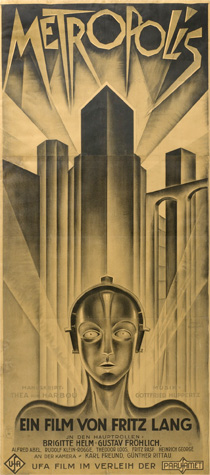
Original 1927 theatrical release poster for the pioneering film "Metropolis.". ( Credit.) 10I6
March 13—Fritz Lang's culturally influential, silent film "Metropolis" premieres in Germany. A German expressionist epic science-fiction drama film, it is regarded as a pioneering work. "Metropolis," set in a futuristic urban dystopia, follows the attempts of the wealthy son of the city's ruler and Maria, a poor worker, to overcome the vast gulf separating the classes. The film was met with a mixed response with many critics praising its technical achievements and social metaphors while others derided it as simplistic and naïve. 10I7
March 24—Nanjing Incident: After six foreigners have been killed in Nanjing and it appears that Kuomintang and Communist Party of China forces would overrun the foreign consulates, warships of the U.S. Navy and the British Royal Navy fire shells and shot to disperse the crowds. 10I8
April 7—First successful long-distance transmission of an image by Bell Telephone Co. inaugurates the age of television. 10I9
May 20—By the Treaty of Jeddah, the United Kingdom recognizes the sovereignty of Ibn Saud over the Kingdom of Nejd and Hejaz, the future Saudi Arabia. 10I10
May 20–21—Charles Lindbergh makes the first solo, nonstop transatlantic airplane flight, from New York City to Paris, in his single-engined aircraft, "the Spirit of St. Louis." 10I11
May 22—A magnitude 8.6 earthquake in Xining, China kills about 200,000 people. 10I12
September 25—A treaty signed by the League of Nations Slavery Commission abolishes all types of slavery. Finally!!! 10I13
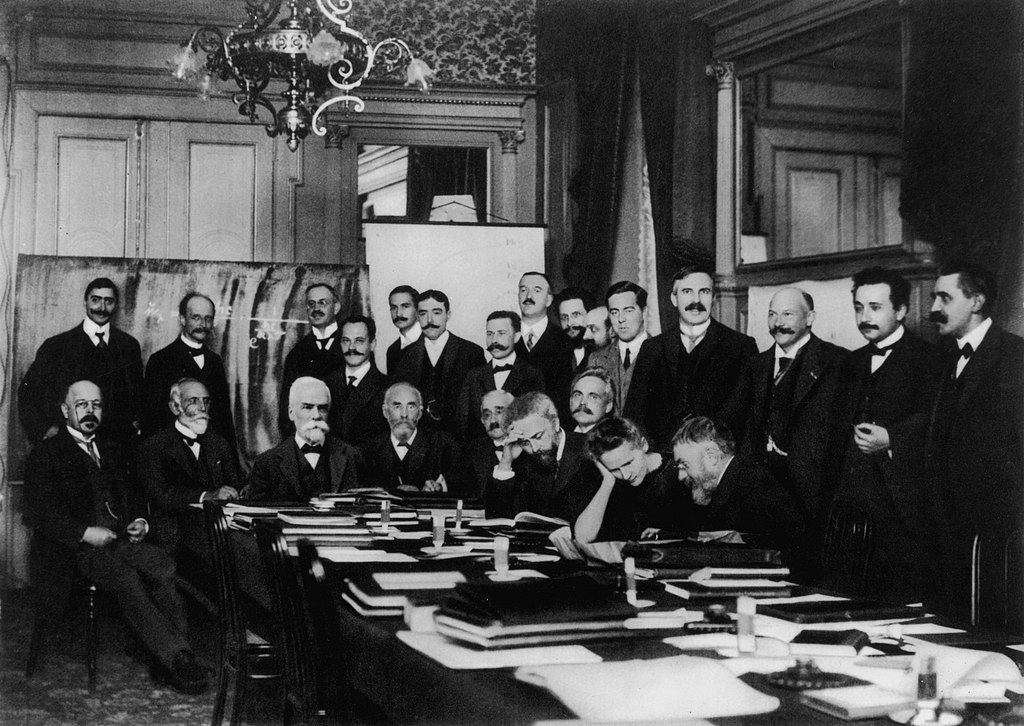 Fifth Solvay Conference. Of the 29 participating phycisists, 17 became Nobel Prize winners. Back row, l.to r.: A. Piccard, E. Henriot, P. Ehrenfest, E. Herzen, Th. de Donder, E. Schrödinger, J.E. Verschaffelt, W. Pauli, W. Heisenberg, R.H. Fowler, L. Brillouin. Middle row: P. Debye, M. Knudsen, W.L. Bragg, H.A. Kramers, P.A.M. Dirac, A.H. Compton, L. de Broglie, M. Born, N. Bohr. Fronth row: I. Langmuir, M. Planck, M. Sklodowska-Curie, H.A. Lorentz, A. Einstein, P. Langevin, Ch.-E. Guye, C.T.R. Wilson, O.W. Richardson. ( Credit.) 10BI14
October—The Fifth Solvay Conference, held in the latter half of the month, establishes the acceptance of the Copenhagen interpretation, a loosely-knit informal collection of axioms or doctrines that attempt to express in everyday language the mathematical formalism of quantum mechanics. The interpretation was largely devised in the years 1925–1927 by Niels Bohr and Werner Heisenberg. It is fundamental to the Copenhagen interpretation that the results of experiments must be reported in ordinary language, not relying on arcane terminology or words that refer only to clusters of mathematical symbols. The fundamental axiom of the Copenhagen interpretation is the "postulate of the quantum", that subatomic events are only perceptible as indeterministic physically discontinuous transitions between discrete stationary states. Various consequences are inferred from this postulate of unpredictable physical discontinuity. 10I15
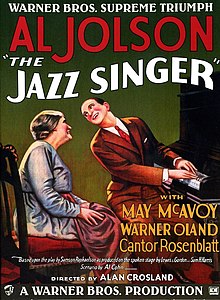
Theatrical release poster for "The Jazz Singer." ( Credit.) 10I16
October 6—The first feature-length motion picture with synchronized dialogue sequences, "The Jazz Singer" with Al Jolson, opens in the U.S. and becomes a huge success, although silent films do continue to be made for some time. 10I17
October 2—Died: Svante Arrhenius, Swedish physicist and chemist, Nobel Prize laureate (born in 1859). He is one of the first physical chemists and developed a still commonly applied acid-base theory. He determined that reactions in living organisms and in the test tube followed the same laws. He also turned his attention to the origin of ice ages, to astronomy, physical cosmology, and astrophysics, accounting for the birth of the solar system by interstellar collision. He considered radiation pressure as accounting for comets, the solar corona, the aurora borealis, and zodiacal light. Arrhenius thought life might have been carried from planet to planet by the transport of spores (panspermia). He embraced the idea of a universal language and proposed a modification of the English language. 10I18
December—After Leon Trotsky was expelled from the Soviet Communist Party, leaving Joseph Stalin with undisputed control of the Soviet Union, the Communist Party Congress condemns all deviation from the general party line. 10I19
December 27—Kern and Hammerstein's musical play, "Show Boat," based opens on Broadway and goes on to become the first great classic of the American musical theater. Also that day: the world's population reaches two billion. To think that three and a half times as many people have been added during my lifetime so far! 10I20
Nobel Prizes in 1927:
Physics: Arthur Holly Compton and Charles Thomson Rees Wilson. To Compton "for his discovery of the effect named after him" and to Wilson "for his method of making the paths of electrically charged particles visible by condensation of vapour."
Chemistry: Heinrich Otto Wieland, "for his investigations of the constitution of the bile acids and related substances."
Physiology or Medicine: Julius Wagner-Jauregg, "for his discovery of the therapeutic value of malaria inoculation in the treatment of dementia paralytica."
Literature: Henri Bergson. "in recognition of his rich and vitalizing ideas and the brilliant skill with which they have been presented".
Peace: Ferdinand Buisson and Ludwig Quidde. From the presentation by Fredrik Stang*, Chairman of the Nobel Committee: "This year we pay tribute through the Nobel Prize to a different kind of work for the cause of peace. Governments and their policies are not the only potential menace to peace. A constant and real threat of war also lies in the mentality of men, in the psychology of the masses. Therefore the great organized work for peace must be preceded by the education of the people, by a campaign to turn mass thinking away from war as a recognized means of settling disputes, and to substitute another and much higher ideal: peaceful cooperation between nations, with an international court of justice to resolve any disagreements which might arise between them. It is in the task of reorienting public opinion that Buisson and Quidde have played such prominent roles. They have guided this work in two countries where it has been particularly difficult to accomplish, but where the need for it has been commensurately great. In presenting the Nobel Peace Prize to Buisson and Quidde, the Nobel Committee wishes to recognize the emergence in France and Germany of a public opinion which favors peaceful international cooperation. It is this happy circumstance which brought about the rapprochement between Germany and France, which in turn found expression in the events rewarded at last year's award ceremony."* 10I21
1955: Marc van Eyken was born.—On January 7 of that year, Marian Anderson becomes the first African-American singer to perform at New York City's Metropolitan Opera. 10J
January 17—USS Nautilus, the first nuclear-powered submarine, puts to sea, from Groton, Connecticut. 10J
January 19—The game "Scrabble" debuts. 10J
January 22—The Pentagon announces a plan to develop ICBMs (intercontinental ballistic missiles) armed with nuclear weapons. 10J
March—A young Jim Henson builds the first version of Kermit the Frog. 10J

Claudette Colvin on the cover of a book by Phillip Hoose. ( Credit.) 10I16
March 2—In Montgomery, Alabama, 15-year-old Claudette Colvin refuses to give up her seat on a bus to a white woman after the driver demands it. She is carried off the bus backwards while being kicked and handcuffed and harassed on the way to the police station. 10J
March 11—Died: Sir Alexander Fleming, Scottish scientist, recipient of the Nobel Prize in Physiology or Medicine (born in 1881). Fleming had shown that, if Penicillium rubens were grown in the appropriate substrate, it would exude a substance with antibiotic properties, which he dubbed penicillin. 10J
March 17—Richard Riot in Montreal: 6,000 people protest the suspension of French Canadian ice hockey star Maurice Richard of the Montreal Canadiens by the National Hockey League following a violent incident during a match. 10J
April 15—Ray Kroc opens his first McDonald's in Des Plaines, Illinois. "His," not "the," for McDonald's existed well before Kroc came into the picture. The McDonald brothers, realizing that most of the profits in various business ventures, came from selling hamburgers, established a streamlined system with a simple menu of just hamburgers, cheeseburgers, french fries, shakes, soft drinks, and apple pie in 1948. In October 1948, after the McDonald brothers realized that most of their profits came from selling hamburgers, they closed down their successful carhop drive-in to establish a streamlined system with a simple menu of just hamburgers, cheeseburgers, french fries, shakes, soft drinks, and apple pie. Believing the McDonalds' formula was a ticket to success, Kroc suggested they franchise their restaurants throughout the country. The brothers were skeptical. Kroc then acquired the rights to set up McDonald's restaurants throughout the country, except in a handful of territories in California and Arizona already licensed by the McDonald brothers. The brothers were to receive one-half of one percent of gross sales. 10J
April 18—Died: Albert Einstein, German-born physicist, Nobel Prize laureate (born in 1879). Well, who doesn't know that he was a pretty bright fellow? 10J
July 13—Ruth Ellis, hanged for murder in London, became the last woman ever to be executed in the United Kingdom. 10J
July 28—The first Interlingua Congress in Tours, France, leading to foundation of the Union Mundial pro Interlingua. Interlingue is among the more prominent artificial languages, among which Esperanto tops the list. 10J
August 12—Died the Nobel Laureates: Thomas Mann, German author with a strong social conscience,(born in 1875) and James B. Sumner, American chemist (born in 1887). Thomas Mann received the Nobel Prize for Literature in 1929, "principally for his great novel, 'Buddenbrooks,' which has won steadily increased recognition as one of the classic works of contemporary literature." 10J
August 27—First edition of the "Guinness Book of Records," published, in London. 10J
September 15—Vladimir Nabokov's controversial novel "Lolita" published. It attained a classic status, becoming one of the best-known and most controversial examples of 20th century literature and has been adapted for film and stage. The name "Lolita" has entered pop culture to describe a sexually precocious girl. 10J
November 1—Died: Dale Carnegie (born in 1888), American writer, lecturer and developer of famous courses in self-improvement, salesmanship, corporate training, public speaking, and interpersonal skills. Was the author of the massive bestseller "How to Win Friends and Influence People," "How to Stop Worrying and Start Living," and several other books. One of his core ideas was that it is possible to change other people's behavior by changing one's behavior toward them. 10J
December 22—American cytogeneticist Joe Hin Tjio discovers the correct number of human chromosomes, 46. 10J
December 31—General Motors becomes the first American corporation to make a profit of over one billion dollars in one year. And the world's population reaches 2,755,823,000. 10J
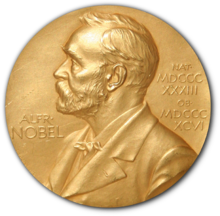
Alfred Nobel was a Swedish armaments producer and the inventor of dynamite. By his last will he establsihed the annual Nobel Prize for outstanding contributions that benefit mankind. ( Credit.) 10J
Nobel Prizes 1955:
Physics: Willis Eugene Lamb and Polykarp Kusch. Lamb, "for his discoveries concerning the fine structure of the hydrogen spectrum." Kusch, "for his precision determination of the magnetic moment of the electron"
Chemistry: Vincent du Vigneaud, "for his work on biochemically important sulphur compounds, especially for the first synthesis of a polypeptide hormone"
Physiology or Medicine: Axel Hugo Theodor Theorell, "for his discoveries concerning the nature and mode of action of oxidation enzymes"
Literature: Halldor Kiljan Laxness, "for his vivid epic power which has renewed the great narrative art of Iceland"
Peace: not awarded. 10J
|
![]() return to main text
return to main text
